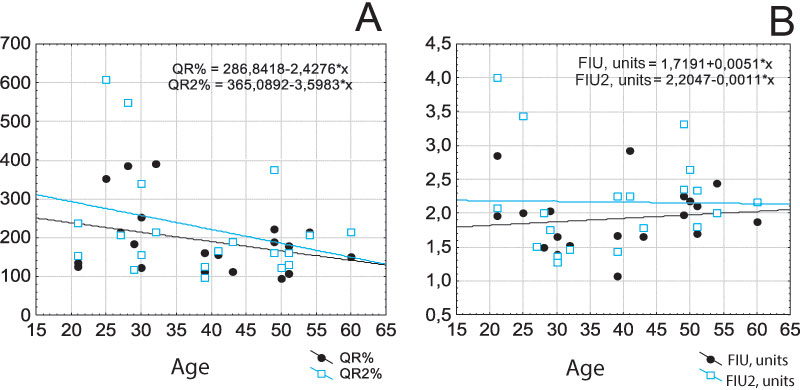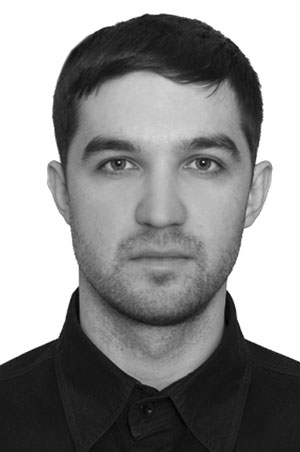Specifics of regulation of vertical stability of multiaged women at rest and after training on force platform
Фотографии:
ˑ:
S.I. Loginov, professor, Dr.Biol. Laboratory of biomechanics and kinesiology, Surgut state university KhMAR-Ugra, Surgut
Key words: vertical stability, body balance, stabilometry with feedback, training, physical exercises, women, age of 20-60.
Introduction. Human ability to maintain balance at rest and when walking on a flat surface usually declines [4, 1] along with the rising risk of falling and traumas [10]. Theoretically, until recently the vertical stability control has been considered as a total of static reflexes that failed to explain the phenomenon of postural stability. Nowadays the dominant idea is that balance regulation is a set of skills formed in view of the interrelation of dynamic sensor processes of posture orientation and posture equilibrium [6, 7, 5, 8]. These skills can be mastered and trained in any age based on postural tremor arising every time somebody tries to maintain stable position against the gravitational forces [3].
The purpose of the study was to consider the specifics of vertical stability regulation in multi-aged women before and after training on the stabilometric platform with feedback.
Organization and methods. 10 women of the second period of maturity (49,8±6,1 years) and 10 women of the first period of maturity (28,2±5,3 years) were the subjects of the comparative experiment. The women were distributed into 2 groups at random 10 persons each regardless their age. The participants of the group 1 performed sets of conditioning exercises (CE) and rehabilitation games (RG) on the stabilometric platform (experimental group – EG).
The second group of women executed CE only, but trained without the platform (control group – CG). The trainings lasted 60 minutes, three times a week during 4 weeks. CE included aerobic exercises (15-20 min), power exercises using simulators (20-25 min), stretching and breathing exercises.
The parameters of women’s vertical stability were studied by means of stabilometry using the “MBN-Biomechanics” complex. The subjects did 4 tests each 30 sec long before and after RG. The tests were made in the following order: normal stand position eyes open (NSPEO), normal stand position eyes closed (NSPEC), Romberg’s test QR (eyes closed) and QR2 (eyes closed). Rehabilitation games involved 6 tasks, 2 of which provided for training of one-axis movements (left-right) and 4 – two-axis training (left-right, forward-backward), getting more complex during games. 12 parameters were analyzed [4]: Ax, Ay (mm) – the mean position of the center of pressure (CP) in the frontal (X) and sagittal (Y) planes; X, Y (mm) – the standard deviation of the CP in the frontal (X) and sagittal (Y) planes; S (mm²) – the area of statokinesiogram, showing the area of oscillations of the CP; L (mm) – the length of statokinesiogram (LSK) (path passed by the CP for 30 sec); V (mm/s) – the average oscillation rate of the CP; Mаx_X, Max_Y (mm) – the maximum oscillation range of the CP in the frontal (X) and sagittal (Y) planes; FХ, FУ, (Hz) – the power level of the spectrum of oscillation frequencies of the CP in the frontal (X) and sagittal (Y) planes; QR (%) – Romberg’s coefficient (percentage of the index of the area of statokinesiogram at studies with closed and open eyes).
The obtained data were estimated using the Statistica_8.0 software. The arithmetical mean <X> and the standard deviation <SD> were calculated before and after the exposure. Depending on the pattern the reliability of differences between means was measured using the two-sided Student’s or Wilcoxon’s test (significance level P<0,05). The dependence of the examined parameters and age of the subjects was allocated using the variance and regression analyses.
Results and discussion. The conducted study revealed that the Romberg’s coefficient after RG (QR2) in women at the age range from 20 to 60 years decreases compared to the beginning of trainings (QR) and can be described by the dependences of the types: QR = 287-2,47X and QR2 = 365-3,98X (Fig. А), (T). The decrease of the value of the Romberg’s coefficient indicates to the decrease of the load on the visual analyzer and increase of the functional state of proprioceptive and vestibular systems. The index of the balance function, on the contrary, increased after rehabilitation games on the platform (Fig. B) (Table).

Fig. The dependence of the Romberg’s coefficient (A) and the index of functional balance (B) in multi-aged women before (QR, PWC) and after (QR2, PWC2) training on the stabilometric platform.
One substantial difference was detected in the group of women who use conditioning exercises in training between the indices of the value of standard deviation of the center of pressure in the frontal plane with closed eyes (micro-oscillations from side to side) (Table).
The level of the vertical balance regulation increased substantially in the group of women using CE and rehabilitation games on the stabilometric platform with feedback via the decrease of the oscillation of the center of pressure in the frontal and sagittal planes, decrease of the rate of change of the center of pressure with open and closed eyes and decrease of the maximum amplitude of oscillations of the CP in the frontal and sagittal planes (Tab. 1).
Table 1. Stabilometric indices of multi-aged women at the beginning and after 12 sessions on the platform in the normal stand position test, Х±SD
|
Indices |
Group 1 (n=10) |
Group 2 (n=10) |
|||
|
Before |
After |
Before |
After |
||
|
Х, mm |
О |
-3,52±7,91 |
-5,49±7,83 |
-3,14±3,56 |
-4,68±5,11 * |
|
З |
-3,18±4,34 |
-7,80±10,57 * |
-3,84±6,35 |
-6,57±7,4 |
|
|
У, mm |
О |
-35,35±14,12 |
-21,98±19,86 |
-31,98±19,74 |
-32,53±25,1 |
|
З |
-30,19±13,05 |
-19,69±18,69 |
-31,53±15,94 |
-33,34±23,43 |
|
|
Ах, mm |
О |
10,53±8,38 |
6,50±6,07 |
6,04±5,7 |
5,81±2,78 * |
|
З |
16,67±12,66 |
6,73±4,61 |
5,78±3,07 |
5,24±3,67 *^ |
|
|
Ау, mm |
О |
23,20±27,08 |
9,65±5,33 |
12,08±8,46 |
10,69±7,93 |
|
З |
24,16±13,17 |
14,49±9,11 |
16,52±18,87 |
10,08±6,89 |
|
|
L (mm) |
О |
5,06±3,06 |
6,94±3,37 |
6,48±2,85 |
5,47±1,63 |
|
З |
4,99±4,90 |
5,54±2,44 |
6,67±3,02 |
6,87±2,87 |
|
|
V, mm/s |
О |
10,09±1,95 |
9,81±2,33 |
9,23±1,44 |
8,35±1,66 * |
|
З |
14,09±3,34 |
11,10±2,74 |
11,64±2,17 |
10,09±1,47 ^ |
|
|
Mаx X, mm |
О |
15,64±5,46 |
12,08±4,81 |
11,15±3,49 |
11,61±2,15 *^ |
|
З |
19,33±6,24 |
12,96±4,32 |
12,41±3,13 |
11,81±3,71 *^ |
|
|
Mаx У, mm |
О |
20,05±8,7 |
15,49±4,49 |
15,09±4,74 |
14,78±4,76 |
|
З |
22,59±8,07 |
16,99±4,14 |
18,89±7,56 |
14,58±4,77 |
|
|
FХ, Hz |
О |
0,36±0,17 |
0,61±0,35 |
0,49±0,11 |
0,46±0,18 |
|
З |
0,56±0,35 |
0,39±0,16 |
0,36±0,19 |
0,47±0,20 |
|
|
FУ, Hz |
О |
0,44±0,21 |
0,53±0,29 |
0,31±0,15 |
0,32±0,17 |
|
З |
0,47±0,28 |
0,42±0,34 |
0,38±0,21 |
0,42±0,20 |
|
|
QR, % |
178,98±87,91 |
185,99±78,58 |
208,03±95,19 |
121,63±85,92 * |
|
|
PWC, i.e. |
1,79±0,48 |
2,07±0,87 |
2,03±0,44 |
2,39±0,64 * |
|
Legend: * – significantly (p<0.05) within groups, ^ – p<0,05 between groups “after-after” influenced by trainings on the stabilometric platform with feedback. The abbreviation expansion is given in the text.
Proceeding from the literature sources, maintenance of static and dynamic balance is among essential factors determining the quality of life in the middle age. Various diseases, such as discirculatory encephalopathy, caused by arterial hypertension, atherosclerosis or their combination, act as the main reason of imbalance of middle-aged people [5, 7]. Low physical activity is another factor of deterioration of the ability to maintain vertical balance [9]. Overweight also contributes to imbalance in middle-aged people [8]. Our data generally correspond to the ones of numerous researchers, who found out that postural balance is indirectly related to daily physical activity and quality of man’s life [5, 8]. Nevertheless, according to our data, regular physical exercises in the group of multi-aged women result in the increase of the physical fitness level, but do not provoke substantial changes in the indices of vertical balance.
In some studies length and area of statokinesiogram along with the average radius of body not vertical are stated to have such a big spread of values that it is impossible to use them to estimate correctly the dynamics of the balance function. The average rate of movement of the foot center of pressure was proved to be the most reliable index. The index of the quality of balance function objectively showed the maintenance level of the postural system [2, 3]. Here we got similar data.
Hence, the external control effect in the form of the 4 week (12 sessions) set of conditioning exercises had not provoked essential changes in balance regulation, except for more control over the frontal plane with closed eyes. Trainings on the stabilometric platform using rehabilitation videogames with feedback facilitated the increase of women's vertical stability via optimization of the position of the center of pressure (CP), decrease of its maximum oscillation amplitude in the frontal and sagittal planes and decrease of the average oscillation rate of the CP.
References
- Burdakov, V.V. Diagnostics of imbalances in patients with early stages of discirculatory encephalopathy using computer stabilometry / V.V. Burdakov, O.V. Pashkov // Zhurn. radioelektroniki, 2006. – № 2. – P. 35–42. (In Russian)
- Bykov, E.V. The dynamics of stabilometric characteristics in the season in estimation of the functional state of hockey players / E.V. Bykov, N.G. Zinurova, A.A. Pletnev, A.V. Chipyshev // Fundamental'ye issledovaniya. – 2012. – № 9. – P. 796–800. (In Russian)
- Govorun, M.I. Computer stabilometry in diagnostics of vestibular disorders after stapedoplasty and estimation of human functional status / M.I. Govorun. V.I. Usachev, M.S. Kuznetsov, A.E. Golovanov // Vestn. otorinolaringologii. – 2012. – № 4. – P. 57–59. (In Russian)
- Gurfinkel', V.S. Human pose regulation / V.S. Gurfinkel', Ya.M. Kots, M.L. Shik. – Moscow: Nauka, 1965. – 255 P. (In Russian)
- Zinov'eva, G.A. Imbalances of the vertical position in elderly patients and their correction by means of biocontrol by stabilogram: abstract of Ph.D. thesis / G.A. Zinov'eva. – Moscow, 2001. – 21 P. (In Russian)
- Skvortsov, D.V. Clinical motor analysis. Stabilometry / D.V. Skvortsov. – Moscow: Antidor, 2000. – 190 P. (In Russian)
- Yakhno, N.N., Damulin, I.V. Discirculatory (vascular) encephalopathy / N.N. Yakhno, I.V. Damulin// Rossiysky meditsinsky zhurnal. – 1999. – № 5. – P. 3–43. (In Russian)
- Bohannon R.W. Body mass index and mobility of older home care patients / R.W. Bohannon // Physiother Theory Pract. – 2011. – V. 27, № 6. – P. 460–462.
- Bohannon R.W. Normal walking speed: a descriptive meta-analysis / R.W. Bohannon, A.W. Andrews // Physiotherapy. – 2011. – V. 97, № 3. – P. 182–189.
- Bohannon R.W. Number of pedometer-assessed steps taken per day by adults: a descriptive meta-analysis / R.W. Bohannon // Phys. Ther. 2007 V. 87, № 12. – P. 1642–1650.
Author’s contacts: apokin_vv@mail.ru


